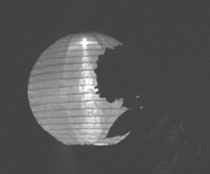I’m really into replacing those old Thomas Edison-era incandescent light bulbs with LED light bulbs because they’re a practical way to significantly reduce our energy consumption and your monthly electrical bill.
But light bulbs are hard to get excited about, so let me try to get your attention with this incredibly cool thing: a solar-powered LED lantern.
I bought it because I knew it would be cool. I’m interested in this technology, so how could I not get this groovy looking faux Japanese lantern with a built in photovoltaic cell, a storage battery, a photosensor and an LED light? Well, I got it and hung it on a tree branch to see if it would actually work. Sure enough, it got dark six hours later — and the thing turned itself on. Cool.
A couple of nights later, I look out the window and see this softly glowing sphere and I feel strangely drawn to it, like I’m a werewolf or something. I’m compelled to go out and give it a good look. At which point I realize this isn’t cool – this is profoundly cool. This is a definitive seeing-is-believing, OMG, this-is-how-it’s-going-to-be-someday moment. Totally free, totally clean energy. This thing spends the day sunbathing; it stores the sunlight in a little battery; and it lights up when it gets dark.
Day after day after day … just like the sun. It’s one thing to know about a technology – it’s quite another to see it work, and know that it does.
This particular device is the ultimate time-shifting technology: it recycles daylight into nightlight. Here, take a 20-second walk walk outside with me:
Maybe you had to be there. But I think this is one of those things that’s like a gateway drug: it might lead you to more and stronger solutions. So if you’ve got a place to hang a little moon of your own …
… Night
Cost Benefit Analysis
The U.S. Department of Energy estimates that widespread adoption of LED lighting in the U.S. over the next 15 years can:
Deliver savings of about $280 billion.
Avoid 133 new power plants
Reduce lighting electricity demand by 62% in 2025.
Eliminate 258 million metric tons of carbon emissions.
Want to buy a LED Light Bulb? Click for links on my Resources page.
